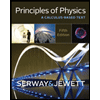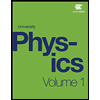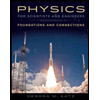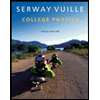When a 3.70-kg object is hung vertically on a certain light spring that obeys Hooke's law, the spring stretches 2.10 cm. (a) If the 3.70-kg object is removed, how far will the spring stretch if a 1.50-kg block is hung on it? cm(b) How much work must an external agent do to stretch the same spring 4.00 cm from its unstretched position?
When a 3.70-kg object is hung vertically on a certain light spring that obeys Hooke's law, the spring stretches 2.10 cm. (a) If the 3.70-kg object is removed, how far will the spring stretch if a 1.50-kg block is hung on it? cm(b) How much work must an external agent do to stretch the same spring 4.00 cm from its unstretched position?
Principles of Physics: A Calculus-Based Text
5th Edition
ISBN:9781133104261
Author:Raymond A. Serway, John W. Jewett
Publisher:Raymond A. Serway, John W. Jewett
Chapter6: Energy Of A System
Section: Chapter Questions
Problem 17P: When a 4.00-kg object is hung vertically on a certain light spring that obeys Hookes law, the spring...
Related questions
Question
When a 3.70-kg object is hung vertically on a certain light spring that obeys Hooke's law, the spring stretches 2.10 cm.
(a) If the 3.70-kg object is removed, how far will the spring stretch if a 1.50-kg block is hung on it?
cm
(b) How much work must an external agent do to stretch the same spring 4.00 cm from its unstretched position?
cm
(b) How much work must an external agent do to stretch the same spring 4.00 cm from its unstretched position?
Expert Solution
This question has been solved!
Explore an expertly crafted, step-by-step solution for a thorough understanding of key concepts.
This is a popular solution!
Trending now
This is a popular solution!
Step by step
Solved in 5 steps with 5 images

Knowledge Booster
Learn more about
Need a deep-dive on the concept behind this application? Look no further. Learn more about this topic, physics and related others by exploring similar questions and additional content below.Recommended textbooks for you

Principles of Physics: A Calculus-Based Text
Physics
ISBN:
9781133104261
Author:
Raymond A. Serway, John W. Jewett
Publisher:
Cengage Learning

University Physics Volume 1
Physics
ISBN:
9781938168277
Author:
William Moebs, Samuel J. Ling, Jeff Sanny
Publisher:
OpenStax - Rice University

Physics for Scientists and Engineers: Foundations…
Physics
ISBN:
9781133939146
Author:
Katz, Debora M.
Publisher:
Cengage Learning

Principles of Physics: A Calculus-Based Text
Physics
ISBN:
9781133104261
Author:
Raymond A. Serway, John W. Jewett
Publisher:
Cengage Learning

University Physics Volume 1
Physics
ISBN:
9781938168277
Author:
William Moebs, Samuel J. Ling, Jeff Sanny
Publisher:
OpenStax - Rice University

Physics for Scientists and Engineers: Foundations…
Physics
ISBN:
9781133939146
Author:
Katz, Debora M.
Publisher:
Cengage Learning

College Physics
Physics
ISBN:
9781305952300
Author:
Raymond A. Serway, Chris Vuille
Publisher:
Cengage Learning

College Physics
Physics
ISBN:
9781285737027
Author:
Raymond A. Serway, Chris Vuille
Publisher:
Cengage Learning

Physics for Scientists and Engineers, Technology …
Physics
ISBN:
9781305116399
Author:
Raymond A. Serway, John W. Jewett
Publisher:
Cengage Learning